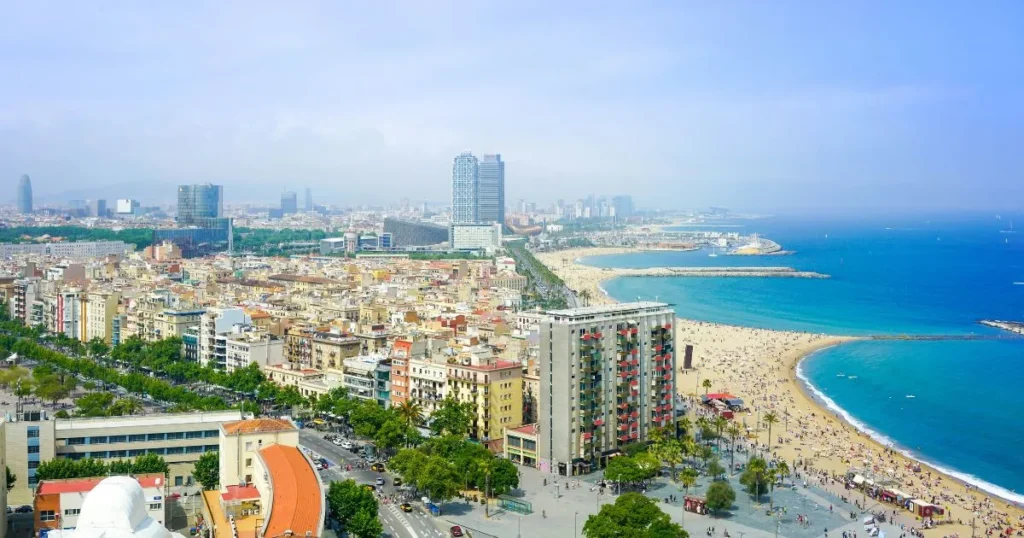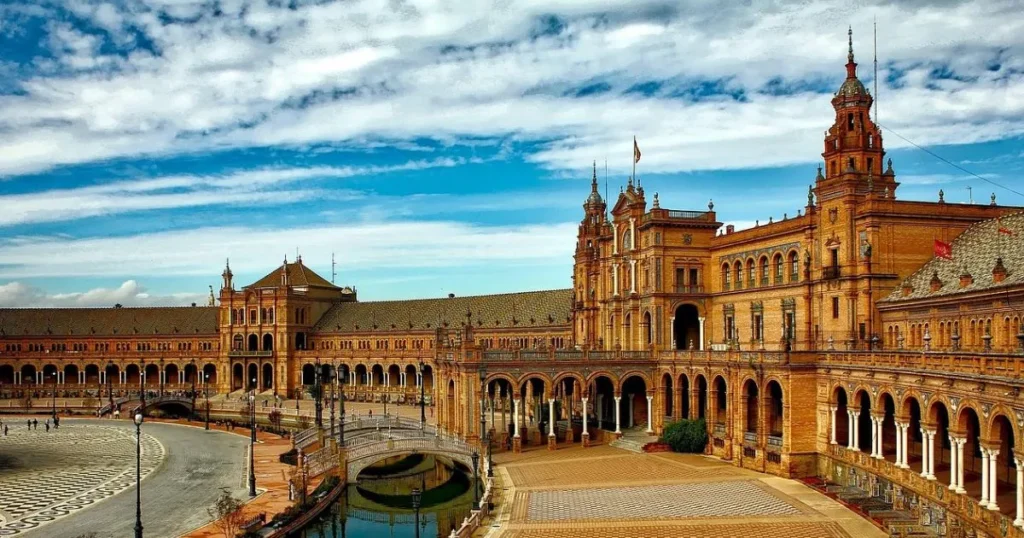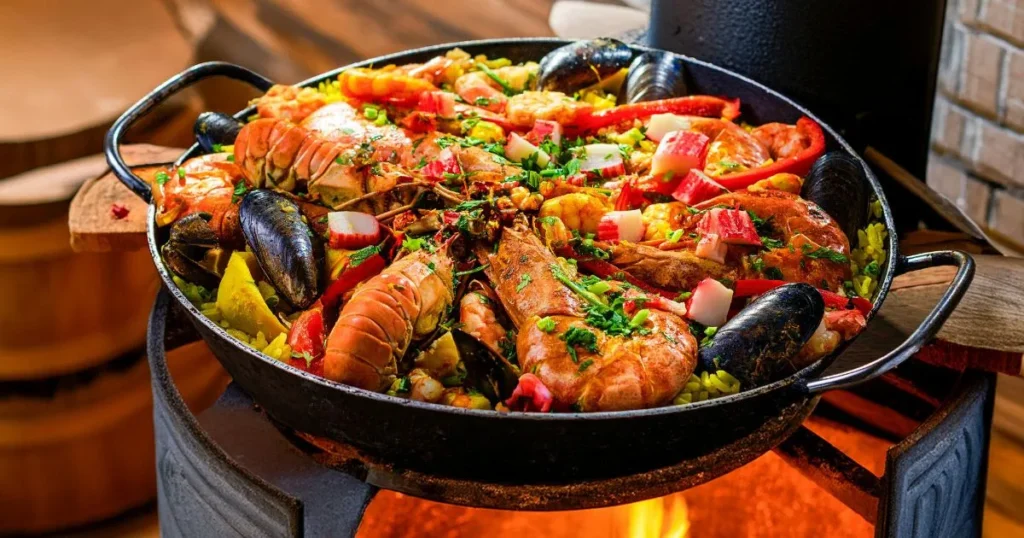Perfect Spain Itinerary: 10 Incredible Days Across Must-See Destinations
Imagine stepping into a world where ancient history meets modern life. Every cobblestone street has a story, and each sunset is a masterpiece. Your journey through Spain promises to be a remarkable adventure that will leave a lasting imprint on your heart.
Spain is a journey through diverse landscapes, rich cultures, and breathtaking sights. This 10-day guide will show you the best of Barcelona, Madrid, Seville, and Granada. You’ll discover Spain’s iconic cities and hidden gems.
Your trip will take you to architectural wonders, amazing food, and a culture full of passion. From Gaudí’s designs in Barcelona to Andalusia’s historic palaces, every moment will be a discovery you’ll never forget.
Table of Contents
Planning Your Perfect Spanish Adventure
Thoughtful planning is essential to fully enjoy your time and stay on budget while exploring Spain. With the right tips, you can explore Spain confidently and affordably. Your goal is to have a memorable trip that includes culture, adventure, and smart spending.
Creating an amazing Spanish journey means paying attention to important details.Every decision—from timing your visit to selecting transportation—plays a crucial role in shaping your trip. These decisions can turn your trip from good to great.
Best Time to Visit Spain
The time of year you decide to visit Spain can significantly affect the overall quality and enjoyment of your trip. Here are some budget-friendly travel tips for Spain:
- Spring (April-May): Mild temperatures and fewer tourists
- Autumn (September-October): Comfortable weather and lower prices
- Avoid peak summer months (June-August) due to extreme heat and crowds
Recommended Duration for Each Destination
Planning your time wisely is key. Here’s a suggested guide for city stays:
- Barcelona: 3-4 days
- Madrid: 2-3 days
- Seville: 2 days
- Granada: 1-2 days
Transportation Between Cities
Spain’s efficient transport network allows for convenient and budget-friendly travel between cities. The AVE high-speed rail system links Spain’s major cities swiftly and with ease. To save money, consider these tips:
- Booking train tickets in advance
- Considering regional train passes
- Comparing prices between train and bus options
Pro tip: Purchase a Renfe train pass for multiple city trips to maximize savings and convenience.
Starting Your Journey in Barcelona

Barcelona greets you with a mix of sea views and city life. It’s the capital of Catalonia, a lively city perfect for starting your Spanish trip. You’ll see why so many people visit here every year.
The city’s beauty is thanks to amazing spanish architecture, especially Antoni Gaudí’s work. Right when you arrive, you’ll see incredible buildings that are both art and structure.
- Stunning Mediterranean coastlines offering panoramic sea views
- Distinctive Gaudí architecture dotting the city with creativity and charm
- Rich cultural experiences in multiple neighborhoods
Upon arrival, Barcelona’s airport offers convenient transport options to reach the city center. Travel tip: Get a transit pass to simplify and save on public transportation. The metro and bus systems make it easy to see barcelona sights.
“Barcelona is not just a city, it’s an experience that captures your imagination” – Local Travel Expert
Your trip to this amazing city will be unforgettable. It’s an excellent way to immerse yourself in Spain’s diverse cultural heritage. Get ready to dive into a place that mixes history, innovation, and Mediterranean charm.
Essential Spain Itinerary: Day-by-Day Guide
Planning a trip to Spain needs careful thought and a sense of adventure. Your 10-day trip will cover the top spots, giving you a mix of culture, architecture, and memories to last a lifetime.
This travel guide splits your Spanish trip into three main areas. You’ll get to know Barcelona, Madrid, and Andalusia well.
Barcelona’s Vibrant First Days
Your journey starts in Barcelona, a city full of amazing buildings and Mediterranean vibes. In these early days, you’ll see:
- Antoni Gaudí’s incredible buildings
- The Gothic Quarter’s old-world charm and winding alleys
- The bustling La Rambla and its vibrant local markets
- Beautiful coastal views and beaches
Madrid’s Cultural Immersion
Next, you’ll explore Madrid, Spain’s capital. Here, you’ll experience:
- World-class museums like the Prado
- Tours of the Royal Palace
- Exploring the historic city center
- Tasting authentic Spanish food
Andalusian Adventure
Andalusia, your final destination, captivates with its deep history and breathtaking scenery. You’ll visit:
- The Alhambra Palace in Granada
- Seville’s historic sites
- Córdoba’s architectural marvels
- Traditional flamenco shows
Every city brings unique moments that will define your unforgettable Spanish adventure.
Barcelona’s Must-See Attractions
Barcelona is a city full of spanish architecture, blending old and new. It’s where historic tradition meets innovative modernity. Here, you’ll find buildings that inspire and share stories of creativity and culture.
Exploring Barcelona, you’ll see why it’s a city of architectural wonders. Its buildings and public spaces offer a memorable experience for all who visit.
Sagrada Familia: Gaudí’s Architectural Masterpiece
Antoni Gaudí’s Sagrada Familia is a top spanish architecture spot. This unfinished basilica mixes gothic and modern styles, making it a must-see. Highlights include:
- Towering spires reaching toward the sky
- Intricate stone facades telling biblical stories
- Stunning stained glass windows
- Unique organic architectural forms
Gothic Quarter: Walking Through History
Walking through the Gothic Quarter feels like time-travel, with its narrow lanes and historic architecture offering a one-of-a-kind journey. You’ll see:
- Medieval palaces
- Hidden squares
- Ancient city walls
- Charming local shops
Park Güell: A Whimsical Urban Landscape
Park Güell is another Gaudí gem. It shows his playful side in spanish architecture. The park offers great views and unique designs that blend with nature.
To enjoy these sights, buy tickets early and arrive early to beat the crowds. Each spot in Barcelona tells a piece of its architectural story, promising a memorable journey through design and history.
Madrid’s Cultural Heritage
Madrid is a city full of life, with a mix of spanish architecture and cultural experiences. It offers a journey through time, combining old and new beautifully.
Starting your journey in Madrid, you’ll find its museums are world-class. The Golden Triangle of Art is a must-see:
- Prado Museum: Housing masterpieces by Velázquez and Goya
- The Reina Sofia Museum proudly houses Picasso’s legendary masterpiece, Guernica.
- Thyssen-Bornemisza Museum: Featuring an extensive international art collection
The Royal Palace is a key part of Madrid’s beauty. It’s known for its stunning spanish architecture. Just steps away, Plaza Mayor invites you to experience local culture and enjoy authentic performances.
Madrid’s cultural depth goes far beyond its museums, revealing a city where history breathes through every street and plaza.
To really get to know Madrid, explore areas like Malasaña and La Latina. These neighborhoods show the city’s lively spirit. Explore bustling markets, cozy tapas bars, and urban art that reflects the pulse of contemporary Madrid.
Exploring Seville’s Historic Center
Seville is the gem of Andalusia tours, offering a unique journey through Spanish architecture and culture. The city’s historic center is alive with centuries of architectural wonders. These will surely capture your imagination.

Walking through the city’s streets, you’ll see a mix of architectural styles. Each tells a story of different historical times. Andalusia tours often focus on three key landmarks that show the city’s architectural greatness.
Royal Alcázar Palace
The Royal Alcázar is a prime example of Mudéjar spanish architecture. This palace has detailed tile work, elaborate archways, and beautiful gardens. It feels like stepping back in time. Key highlights include:
- Stunning geometric patterns
- Beautifully preserved rooms
- Exquisite courtyards
Cathedral and Giralda Tower
Seville’s Cathedral is the largest Gothic religious building in the world. The Giralda Tower next to it offers amazing views and architectural details. Ascending the tower rewards you with sweeping views across the cityscape.
Plaza de España
Plaza de España stands as a stunning example of Spanish architectural brilliance. It features stunning brick design, intricate ceramic tiles, and grand architectural elements. The plaza shows Seville’s artistic and cultural importance.
Insider advice: Reserve your Andalusia tour tickets early to avoid queues and make the most of your visit.
Granada and the Alhambra Palace
Granada is a treasure of Spanish architecture in Andalusia. Your journey starts with the Alhambra Palace, a UNESCO World Heritage site. It draws millions yearly with its stunning Islamic design and deep history.
Make sure the Alhambra is on your list for andalusia tours. It offers a unique look into Spain’s Moorish past. You’ll see amazing geometric patterns, beautiful courtyards, and detailed tile work.
- Book Alhambra tickets well in advance
- Plan for at least half a day to explore fully
- Consider guided tours for deeper historical insights
Granada has more to see than just the Alhambra. The Albaicín neighborhood is a maze of narrow streets and white houses. Your walk will uncover the city’s rich cultural history.
“Granada is not just a city, it’s a living museum of Spanish architectural evolution.” – Local historian
Visit in spring or autumn for better weather and fewer crowds. Local tour guides can show you the city’s cultural treasures and hidden architectural gems.
Discovering Spanish Cuisine
Exploring Spain’s food scene is a thrilling adventure. Expect to explore a culinary universe full of rich flavors and diverse textures. Your guide to Spanish cuisine starts with the rich food culture that makes Spain a haven for food lovers.

Spain’s food traditions vary greatly, just like its landscapes. Each part of Spain offers signature dishes that reflect its cultural identity and regional flavors.
Regional Food Specialties
- Valencia: Home of the authentic paella, featuring saffron-infused rice with seafood or meat
- Catalonia: Known for calcots (grilled green onions) and sophisticated Barcelona cuisine
- Andalusia: Famous for cold gazpacho and fresh seafood dishes
- Basque Country: Renowned for innovative pintxos and world-class restaurants
Best Tapas Experiences
Tapas are more than just food; they’re a way to connect with others. In Spanish cuisine, tapas are small plates meant to be shared. Each city has its own tapas culture:
- Madrid: Traditional taverns with classic tapas like patatas bravas
- Barcelona: Modern tapas bars with creative interpretations
- Seville: Street-side tapas bars with authentic Andalusian flavors
Wine Tasting Opportunities
Exploring Spain’s wine regions is a must. From Rioja’s bold reds to Jerez’s famous sherry, wine lovers will find plenty to enjoy.
“In Spain, food is not just sustenance – it’s a celebration of life and culture.”
Accommodation Guide for Every City
Budget-conscious travel in Spain starts with picking the right accommodations. Your lodging can greatly affect your experience and your wallet. From luxury stays to budget hostels, Spain has lodging to suit every type of traveler.
For those watching their budget, hostels are a great choice in cities like Barcelona and Madrid. These affordable places offer:
- Shared dormitory rooms
- Kitchen facilities for self-catering
- Social spaces to meet fellow travelers
- Central locations near major attractions
Travelers looking for a bit more comfort can check out vacation rentals and boutique hotels. Here are some spain travel tips to help you save money:
- Book accommodations during shoulder seasons
- Use price comparison websites
- Consider apartments in residential neighborhoods
- Look for places with kitchen facilities
Pro tip: In cities like Seville and Granada, think about staying in pensiones or family-run guesthouses. These offer authentic experiences at good prices.
Remember, your accommodation is more than just a place to sleep—it’s part of your Spanish adventure!
Travel Tips and Cultural Insights
Traveling to Spain is more than just packing and being adventurous. Understanding local customs can enrich your Spanish travel experience. Use these expert tips to navigate Spain with confidence and ease.
Getting the hang of Spanish daily life is key. The siesta is real, and many places close from 2-5 PM. Also, meals are different here:
- Lunch starts around 2-3 PM
- Dinner is after 9 PM
- Expect to eat late at night
Staying safe is important. Tourist spots can have pickpockets. Here’s how to stay safe:
- Use bags with secure zippers
- Keep wallets in front pockets
- Be careful in crowded places
Traveling on a budget? Use local tips. Many museums are free at certain times. Public transport is cheap for city tours. Learning Spanish phrases will make you popular with the locals.
“When in Spain, live like the Spanish do – slowly, passionately, and with great enthusiasm!”
Don’t forget about tipping. It’s not as common in Spain as in the US. A 5-10% tip is nice for good service, but it’s not expected everywhere.
Conclusion
Your 10-day Spain trip has shown you the country’s top spots. You’ve seen Barcelona’s amazing buildings, Madrid’s rich history, and Andalusia’s passionate views. Traveling through Spain offers a valuable glimpse into its diverse cultural landscape.
This itinerary only scratches the surface of Spain’s wonders. Each area has its own special things to see and do. Places like the Basque Country, Galicia, and the Balearic Islands are waiting for you to explore.
Travel is about trying new things. Your trip to Barcelona, Madrid, Seville, and Granada gave you a taste of Spanish life. The memories you made will make you want to see more of this lively country.
Think about your Spanish journey and the desire to explore more. Each city showed you a different side of Spain. This is just the start of your love for this amazing place.
FAQ
When is the ideal time to plan a 10-day journey through Spain?
What is the estimated budget for a 10-day trip to Spain?
When is the ideal time to visit Spain for a 10-day vacation?
What’s the estimated budget for a 10-day vacation in Spain?
FAQ
When is the ideal time to plan a 10-day journey through Spain?
The best times to visit Spain are April-May and September-October. During these months, you’ll enjoy pleasant weather and smaller crowds while touring cities like Barcelona, Madrid, and Seville—minus the summer swelter.
What is the estimated budget for a 10-day trip to Spain?
Budget for a 10-day trip to Spain can range from
FAQ
When is the ideal time to visit Spain for a 10-day vacation?
The best times to visit Spain are April-May and September-October. During these months, you’ll experience pleasant weather and fewer tourists. It’s a great time to explore cities like Barcelona, Madrid, and Seville, avoiding the intense summer heat.
What’s the estimated budget for a 10-day vacation in Spain?
The cost for a 10-day stay in Spain typically varies depending on travel style and accommodation choices. $1,500 to $3,000 per person. This depends on your travel style. Budget travelers spend $50-$100 daily, mid-range travelers $100-$250, and luxury travelers $250-$500.
Is speaking Spanish necessary when traveling across Spain?
Knowing some Spanish is helpful, but many speak English in tourist areas. Learning basic phrases like “hello” and “thank you” can make your trip smoother.
What’s the quickest and most convenient way to travel between cities in Spain?
The AVE high-speed train is the most efficient and comfortable way to travel between Spanish cities. It’s fast, comfortable, and connects major cities. Booking tickets in advance saves money and ensures seats.
How much should I tip in Spain?
Tipping in Spain is less formal. Tipping 5–10% at restaurants is welcomed, though it’s not expected. For taxi drivers and service workers, rounding up the bill or leaving 1-2 euros is common.
What items should I include in my packing list for a 10-day trip to Spain?
Bring breathable, comfy clothes for daytime walks, with layers for changing weather. Essentials include good walking shoes, sunscreen, a hat, and smart-casual outfits for evenings out. Bring adapters and a small daypack for daily trips.
Is Spain safe for tourists?
Spain is very safe for tourists. Remain vigilant and safeguard your personal belongings throughout your trip. Major cities are well-policed and welcoming to visitors.
What are the must-try foods in Spain?
Try paella, tapas, jamón ibérico, gazpacho, tortilla española, and churros. Sample regional cuisine in cities like Barcelona, Madrid, and Seville, where each area offers its own culinary delights.
Is it necessary to reserve tickets for attractions ahead of time?
Yes, book attractions like the Sagrada Familia and Alhambra in advance. They often sell out weeks or months ahead, especially in peak seasons. Online booking can save you from long lines.
How does Spain’s traditional siesta influence your daily travel plans?
The siesta is a traditional afternoon rest period, usually from 2-5 PM. While less common in big cities, some shops and businesses might close. In tourist areas, most places stay open, but be aware of possible reduced hours in smaller towns.
,500 to ,000 per person. This depends on your travel style. Budget travelers spend -0 daily, mid-range travelers 0-0, and luxury travelers 0-0.
Do you need to know Spanish when traveling to Spain?
Knowing some Spanish is helpful, but many speak English in tourist areas. Learning basic phrases like “hello” and “thank you” can make your trip smoother.
What is the most convenient mode of transportation for traveling between cities in Spain?
Spain’s AVE high-speed rail system offers the fastest and most comfortable intercity travel option. It’s fast, comfortable, and connects major cities. Booking tickets in advance saves money and ensures seats.
How much should I tip in Spain?
Tipping in Spain is less formal. In restaurants, leaving a 5-10% tip is appreciated, though not mandatory. For taxi drivers and service workers, rounding up the bill or leaving 1-2 euros is common.
What essentials should I bring for a 10-day trip to Spain?
Bring breathable, comfortable clothing ideal for walking, and pack layers for changing weather. Essentials include sturdy shoes, sun protection, and smart-casual outfits for evening outings. Bring adapters and a small daypack for daily trips.
Is Spain safe for tourists?
Spain is very safe for tourists. Stay alert and keep your possessions safe. Major cities are well-policed and welcoming to visitors.
What are the must-try foods in Spain?
Try paella, tapas, jamón ibérico, gazpacho, tortilla española, and churros. Every region has unique dishes, so make sure to taste local specialties in places like Barcelona, Madrid, and Seville.
Should I reserve tickets for attractions ahead of time?
Yes, book attractions like the Sagrada Familia and Alhambra in advance. They often sell out weeks or months ahead, especially in peak seasons. Online booking can save you from long lines.
What is the siesta, and how might it impact your travel plans?
The siesta is a traditional afternoon rest period, usually from 2-5 PM. While less common in big cities, some shops and businesses might close. In tourist areas, most places stay open, but be aware of possible reduced hours in smaller towns.

